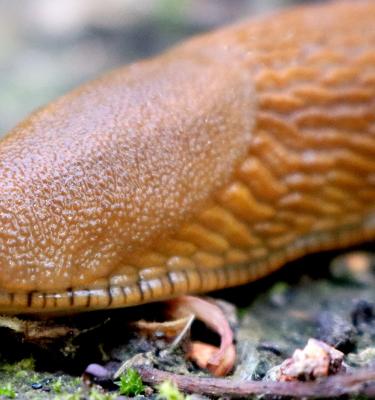

Slugs and Snails
What are slugs and snails?
Slugs and snails are the most common garden plant pests. They are present in large numbers and can quickly eat and destroy a wide range of plants. Garden snails and slugs eat vegetables and ornamental plants, especially seedlings and those with young and soft leaves.
There’s probably no need to tell you what they look like. Their silvery trails will tell you where they came from – and where they went to – after lunching on seedlings and leaves of numerous garden plants. They especially like vegetables and hostas. Here are a few interesting, even amazing, slug and snail facts that will give you some clues as to just what you're up against!
Where do slugs live?
Many of the most damaging slugs spend most of their time living in the soil. On average, 200 slugs live in a cubic metre of soil. That means in an average-sized garden there can be up to 15,000 slugs! Slugs and snails love mild and damp weather, but slugs will still be active in the winter if the temperature stays above 5°C.
How long do slugs live?
It takes about a year for slugs to mature into adult garden slugs which live for about two years.
How long do garden snails live?
Newly-hatched snails have fragile shells and take about two years to mature and generally live for up to five years.
Although there are numerous types of slugs, they don’t all eat and damage plants. Some are carnivorous and even eat other slugs! As for snails the most damaging species is the brown garden snail (Helix aspersa). The smaller banded species (Cepaea) are less voracious.
Slug and snail symptoms and damage
Slugs and snails feed with a rasping tongue which causes irregular holes in leaves and sometimes in stems and flowers. Silvery slime trails are often present. Some underground-dwelling slugs make small, round holes in the skin of potato tubers, root crops such as carrots or tulip bulbs.
How to get rid of slugs and snails
So, how to get rid of slugs and snails? And how can you stop slugs eating plants?
Every gardener has their own favourite slug and snail control or snail and slug deterrent. Here are some to try, ranging from cultural and biological controls to chemical treatment.
- Eggshells, grit, coffee grounds, coal fire ash or crushed eggshells. Slugs and snails don’t like clambering over sharp or rough surfaces so create a slug and snail barrier by laying a thick layer of these substances around susceptible plants.
- Hand removal. Pick up slugs and snails whenever you see them. It’s a good idea to check underneath favourite hiding places like loose slabs or bricks or under flower pots.
- Beer traps. Half fill a jam jar with beer. Sink it into the soil, with its rim approximately 1cm (0.5in) above the soil surface (to prevent predators of slugs, like beetles, from falling in). The aroma never fails to attract slugs and in seeking its source the pests simply fall in and drown.
- Biological snail or slug control. Slug species which live underground can be treated with minute parasitic worms called nematodes (Phasmarhabditis hermaphrodita). In spring and autumn, when the temperature is above 5°C (40°F), water them onto moist, well-drained soil. The nematode penetrates the slug and releases bacteria which kills the slug. They are available from many mail order biological control suppliers and are effective in getting rid of slugs for at least six weeks.
- Slug pellets. An effective way to protect your plants from slug and snail damage is to use slug pellets containing ferric phosphate. During mild, damp weather, scatter the slug pellets thinly on the soil around vulnerable plants. If you are a parent or pet owner, we recommend that you keep slug pellets out of the reach of children and pets: both when you store them and when you use them. Do not pile up the pellets under bricks or half grapefruit skins.
How to prevent slugs and snails
No garden will ever be free of slugs and snails and the best approach is to protect vulnerable plants as far as possible. If you come across a slug or a snail pick it up and dispose of it but don’t throw it over the fence – they have a ‘homing’ instinct and will come back! Some gardeners pop slugs into the compost heap – because they feed on decaying plant material they can be used as part of the composting process.
Here are a few ideas to try to prevent slugs and snails on plants:
- Dead and rotting plant material. By clearing this up you remove food and shelter for slugs and snails.
- Do not dig. Adopt a ‘no dig’ policy. By digging in the autumn you leave the soil rough and cloddy while the slugs are still active which allows those species that hibernate to move deep into the soil. If you have to dig, dig in the winter while the soil is cold and the slugs are less active. This helps to kill some slugs, and exposes them to predators such as birds.
- Beneficial creatures. Several animals and birds eat slugs and snails, so encourage these creatures into your garden. Frogs and newts are all partial to slugs and snails and can be attracted to your garden by building a wildlife pond. Birds like song thrushes are particularly fond of garden snails and like to nest in tall hedges. Blackbirds also feed on snails – by putting bird food containing sunflower seeds and mealworms on a ground feeder tray you will find that blackbirds will start to visit your garden and eat any snails they can find. Hedgehogs, slow-worms and ground beetles also feed on slugs and snails.
- Natural slug bait. Be prepared to sacrifice a crop of something that slugs and snails love to eat, such as brassica or lettuce. Hoe some of this off while the plants are small, leave the hoeings on the soil and get ready to collect and dispose of them.
- Potatoes. As soon as the tubers have matured, lift and store them and don’t leave them in the ground. Avoid growing cultivars like ‘Maris Piper’ and ‘Cara’ which are susceptible to underground slugs, and grow ‘Pentland Ivory’ or ‘Charlotte’ instead.
- Hostas and dahlias. Grow ornamental plants like these in containers such as rough wooden tubs or terracotta pots, out of the reach of slugs.
- Grow plants that slugs don’t like. Slugs tend to avoid herbaceous plants with tough, hairy leaves or spiny leaves or flowerheads. Examples include spurges (Euphorbia species), bear's breeches (Acanthus mollis), elephant's ears (Bergenia) and mullein (Verbascum species).
- Stop slugs coming into the house by sealing any potential entrance points and placing a strip of copper tape on the floor by the door as a barrier.












